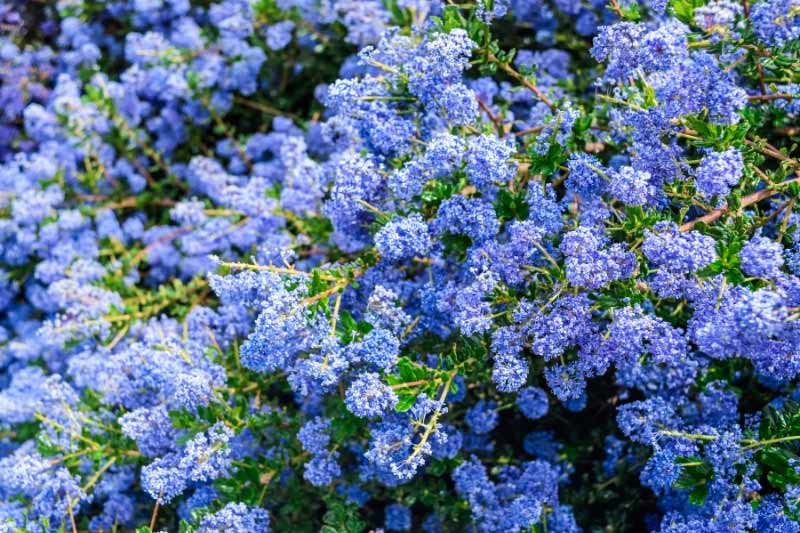
Pruning Ceanothus densifies it and encourages more abundant flowering
When to prune Ceanothus?
- Evergreen Ceanothus should be pruned after flowering (for example Ceanothus 'Skylark', thyrsiflorus repens or Ceanothus arboreus 'Trewithen Blue' for example)
- Deciduous Ceanothus should be pruned in March (for example Ceanothus delilianus 'Gloire de Versailles' or Ceanothus pallidus). During summer, remove faded flowers from summer-flowering varieties to encourage a second flowering in autumn.
- Every 3–4 years or if frost has damaged Ceanothus, carry out a harder prune by cutting back about one-third of the branching to remove dried branches and maintain a compact habit. This pruning is done in early April and plant will not flower in pruning year.
Why prune Ceanothus?
Pruning California lilac helps retain a dense, bushy habit. Indeed, this vigorous bush grows quickly and shoots can sometimes elongate at expense of overall shape. Pruning encourages ramification. It also removes faded flowers, particularly when pruning evergreen Ceanothus immediately after flowering.
Pruning also allows renewal of ageing specimens that have adopted an unbalanced habit and accumulated dead wood.
How to prune Ceanothus?
Required equipment
To prune your California lilac, equip yourself with
- shears and hedge trimmers,
- pruning shear
- and/or loppers for heavier cutting involving larger branch sections.
Pruning shear and loppers are more effective on older, bushy specimens with robust branches, while well-sharpened shears make quick work of numerous spent shoots and help reshape bushes planted as hedging.
For specimens planted as clipped hedge, pruning can be done carefully with electric or petrol hedge trimmer with sharp blades. This method is not best for clean cuts and should be reserved for long stretches of hedging.

Loppers, hedge trimmer shears and a well-sharpened pruning shear: tools needed for manual pruning of Ceanothus
Maintenance pruning: to preserve an attractive silhouette
It helps maintain a dense habit and promotes abundant flowering on Ceanothus. A very light prune is enough to remove spent inflorescences.
- With shears or a pruning shear, cut shoot tips, rounding the bush's silhouette and reducing volume where necessary. Respect natural shape except for clipped hedges and specific forms (standard trained as a ball on a stem, for example)
- Remove dead wood and branches that unbalance the silhouette
- For Ceanothus in clipped hedge, follow hedge line, stepping back regularly. Prune both sides keeping trimmer vertical and top keeping it horizontal
- For trained Ceanothus, woody shoots will harden. Prune to maintain desired shape and to encourage vertical branch shoots.

Adapt pruning to habit of your Ceanothus: trained against a wall, natural habit bush, pruned into a ball or as a hedge
Pruning an ageing specimen: for a new lease of life
Rejuvenation pruning may be necessary on ageing, unbalanced or damaged Ceanothus, or if it becomes too large. This involves removing all old shoots and dead or damaged branches, especially for evergreen Ceanothus which cannot reliably reshoot on old wood.
Deciduous species can produce new shoots from stump, so pruning may be more severe and you can remove more than half of oldest branches at base if needed. This pruning is done at end of winter before growth resumes and after risk of severe frost has passed.
A few final precautions
- Always clean pruning tools with soapy water then disinfect with alcohol before and after use to avoid transmission of diseases between specimens. Sharpen, dry and oil them after cleaning to prevent rust and seizing: tools will stay like new for years
To go further :
- Discover our many varieties of Ceanothus
- Learn everything about California lilac in our complete factsheet: "Ceanothus, California lilac: planting, maintenance, pruning"































